A Guide to Growing Australian Natives
Australian native plants are well-loved by gardeners – and for good reason. They are bright, beautiful and hardy, coming in a variety of colours, sizes and shapes to suit the style of any garden.
Growing Australian natives is one of the best ways to showcase Australia’s natural beauty while also providing a better environment for local wildlife. Native Australian plants offer a wide variety of options including small and large trees, or shrubs, depending on the species. Gardeners who plant a mix of Australian native plants for garden use have the most success by grouping varieties together that require similar growing conditions.
What are Australian Native Plants?
Australia is home to a variety of plants that grow naturally in this continent. Some of the most popular Australian natives include the Callistemon, also known as the Bottlebrush; the Grevilleas; the Acacia genus which makes up all Australian wattles; the Banksia; and the Boronia. Other Australian locals include the well-known Eucalyptus; Correa; Hardenbergia; Leptospermum and Chamelaucium.
Naturally occurring throughout the entire country, these beautiful natives have added colour and life to Australia for millenia. There are thousands of different native species originating from each genus, making Australia’s plants some of the most diverse in the world. How to plant Australian native plants will depend on the variety you choose.
Benefits of Growing Australian Native Plants
There are many benefits of growing natives over non-native plants. They are generally easy to grow and easy to care for, as they thrive in most Australian climates and conditions. Some varieties are also very good at assisting other plants in the area, with Acacias for example, helping to restore vegetation to denuded areas. Generally hardy and drought tolerant, most native Australian plants are fast growing and low maintenance, making them a perfect addition to any garden.
How to Grow Native Plants
How to Grow Acacias
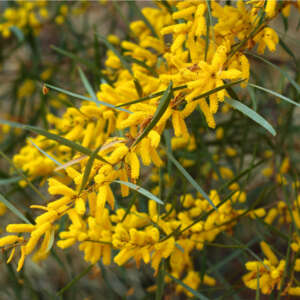
Acacia Floribunda – Garden Express Australia
Climatic Zones
The Acacia genus, more commonly known as the Australian wattle, is the biggest group of trees and shrubs on the continent. They can grow in a range of climatic conditions, including coastal areas, tropical climates, arid climates, mountains and more.
Plant Size
The size of the Acacia will vary depending on the species. Bailey Acacia is an Australian variety that can grow to about 6 to 9 metres in height.
When to Plant
As the Acacia is such a diverse species, flowering and the best time of year to plant will vary. Generally, they bloom between late winter and spring.
Soil Preparation
Acacia prefer well-drained soil that gets reliable summer moisture. Fortunately for many parts of Australia, Acacia are also drought tolerant.
How to Plant
Acacia are mostly grown by seed or through potted plants. The best place to plant Acacia is in an area that gets full sun.
Plant Care
As one of the most popular native flowering plants in Australia, it’s important to give them special care. Acacias should be lightly pruned after they have flowered to prolong the plant’s life. In some cases, your Acacia may self-sow and become a weed.
How to Grow Banksias
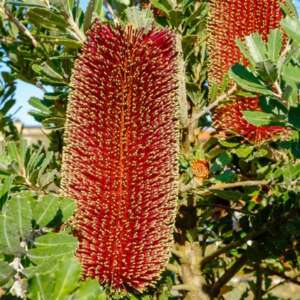
Banksia Praemorsa Red Dawn Pplbanprd
Climatic Zones
Banksias are fast growing Australian native trees that can thrive in most climates. Once your Banksia plants are established, you can also expect them to be frost tolerant.
Plant Size
Plant size can differ depending on your chosen Banksia species. While some Banksias are low growing shrubs, tree varieties can grow as big as 25m in height.
When to Plant
The best time to plant your Banksia variety is in spring and autumn, when the air temperature is cool but not too cold.
Soil Preparation
When growing Australian natives such as the Banksia, ensure you’ve chosen an area with sandy, well-drained soil.
How to Grow Boronias
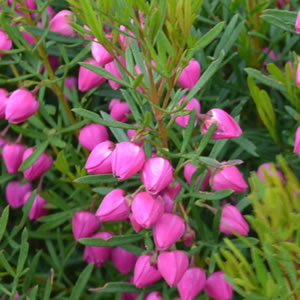
Boronia Heteropylla Pink
Climatic Zones
Boronias can successfully grow in a number of climates, including warm, Mediterranean and cool. It is also a frost-tolerant native Australian plant.
Plant Size
Boronias typically grow to become a medium-large sized shrub. The maximum size of your Boronia will depend on the growing conditions and how well the Australian native is looked after.
When to Plant
You can plant Boronias at any time of the year, making them the perfect choice for some spontaneous gardening.
Soil Preparation
Boronias, much like other native Australian plants, prefer to be planted in moist, but well-drained soil. It’s important that the Boronia’s roots don’t dry out. If possible, plant your Boronia in sandy, slightly acidic soil.
How to Plant
Plant your Boronia in a spot that gets sufficient morning sunlight and is well protected from the wind. If the area gets equal parts sun and shade, your Boronia plant will likely thrive.
Plant Care
To minimise the risk of fungus growing on the roots and crown of your Boronia, it’s a good idea to mulch the area around your native Australian plant with a layer of gravel. This helps to lower the humidity around the base. When your Boronia is about to bud and bloom, make sure to keep it well watered.
How to Grow Callistemon
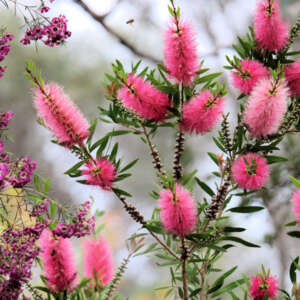
Callistemon Prestige Pink – Garden Express Australia
Climatic Zones
Callistemon, more commonly known as the Bottlebrush, grows best in cool to mild tropical climates.
Plant Size
The size of your Callistemon will vary depending on the variety you choose. They can range from 50cm to up to 4 metres tall and are either Australian native ground cover plants, shrubs or small trees.
When to Plant
You can plant any Callistemon variety at any time of the year.
Soil Preparation
Growing Australian natives such as Callistemon is most easily achieved with moist, well-drained soil. Callistemon can grow in a wide variety of soil types, but prefer slightly acidic soil to thrive.
How to Plant
To plant your Callistemon, dig a hole that is 2-3 times as wide as your plant and ensure the plant crown is kept at soil level. To ensure your Callistemon can produce as many flowers as possible, plant it in an area that gets full sun and part shade.
Plant Care
Caring for Callistemons is important to help them thrive. When the soil surrounding your Callistemon looks dry, water it until the area becomes damp. To help the Callistemon retain water, mulch the area and apply fertiliser annually. Regular trimming will help encourage better growth in the next flowering season and keep the plant tidy.
How to Grow Grevilleas
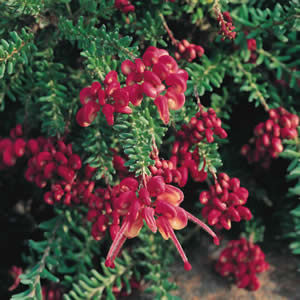
Grevillea Lanigera Prostrate – Garden Express Australia
Climatic Zones
Grevilleas, also known as Spider flowers, are evergreen Australian native ground cover plants that are popular across the country. They are suited to all climatic conditions as there are over 350 species found across Australia. It’s important to check that your chosen species is suitable for your climate before planting.
Plant Size
The size of your Grevillea will depend on the species you choose. Grevillea come as trees, shrubs and ground cover plants.
When to Plant
Grevillea can be planted at any time of the year.
Soil Preparation
This Australian native requires well-draining soil to grow. It likes to be planted in soil that has been mixed with low-phosphorus fertiliser or a potting mix specific for growing Australian natives.
How to Plant
When planting your Grevillea, dig a hole at least double the size of the pot and choose a position in your garden that gets full sun.
Plant Care
Grevilleas respond well to thorough watering as soon as they’ve been planted. Once established, you will only need to give it a deep watering every so often. After the Grevillea has flowered, lightly prune it to help with future growth.
Growing Australian Natives
Looking to grow native Australian plants in your garden? Garden Express has a range of Australian natives suited for all climates. Browse our wide range of natives to find the perfect option for your garden. If you have any enquiries, simply get in touch by calling 1300 606 242, or filling out our online contact form.







Comments are closed.